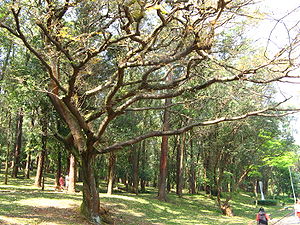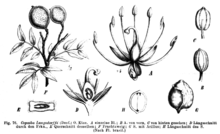Copaifera
| Copaifera | ||||||||||||
|---|---|---|---|---|---|---|---|---|---|---|---|---|

Copaifera spec. |
||||||||||||
| Systematics | ||||||||||||
|
||||||||||||
| Scientific name | ||||||||||||
| Copaifera | ||||||||||||
| L. |
Copaifera is a genus in the subfamily of caesalpinioideae (Caesalpinioideae) within the family of the Leguminosae (Fabaceae). Their original home is the Neotropic and Africa. Some species are grown as ornamental or useful plants in frost-free areas. Some species are threatened by deforestation.
description




Vegetative characteristics
Copaifera species grow as trees or shrubs . Simple, unbranched hairs ( trichomes ) are often present.
The leaves are alternate and arranged in two lines or spirals on the branches ( phyllotaxis ). The compound leaves are pinnate in pairs or unpaired with few or many leaflets . The leaflets arranged alternately to opposite on the rachis each have a strong, continuous lateral nerve and their stalk can be clearly twisted. There are often secretory cavities in the leaves and prismic epidermal crystals. The stomata are paracytic. There are at most very inconspicuous or early falling stipules .
Generative characteristics
The flowers are usually arranged in two rows in branched or simple racemose or panicle inflorescences . The hermaphroditic, only weakly zygomorphic flowers are not five-fold and do not have the typical shape of the butterfly flower, thus different from most of the taxa of the family. The bracts and bracts are no longer present when the flowers are opened. The small, exposed bracts do not encase the flower buds. There are four green to yellow or white, corolla-like sepals , at most fused at their base , which envelop the other parts of the flower in the budding stage. One to four strongly reduced petals are rarely present. The discus is noticeable. There are usually ten, rarely less than ten or up to thirteen stamens . All stamens are fertile and they can all be the same or significantly different lengths. The single carpel contains a few ovules . The ovary is on top.
Lonely legumes are often formed. The seeds sometimes have an aril .
The base number of chromosomes is n = 12; 2n = 24.
Systematics and distribution

They are originally native to the Neotropics and tropical and southern Africa. Today individual species are planted in many areas of the world. The species that are frequently planted are not on the Cites list and are therefore not protected. Some other species are threatened.
The genus Copaifera belongs to the tribe detarieae in the subfamily of caesalpinioideae (Caesalpinioideae) within the family of the Leguminosae (Fabaceae).
The valid botanical genus name Copaifera was published in 1762 by Carl von Linné in Species Plantarum , Editio Secunda, 1, 557. Synonyms for Copaifera L. are: Copaiba Mill. And Copaiva Jacq. ; the valid name Copaifera L. became in Vienna ICBN Art. 14.4 & App. III set in front of the older, now synonymous, names. The type species is Copaifera officinalis (Jacq.) L. , which Nikolaus Joseph von Jacquin had published as Copaiva officinalis in Enumeratio systematica plantarum , 21 as early as 1760 , but of which Willem Piso and Georg Marggraf had published an illustration and description as early as 1648 in Historia Naturalis Brasiliae .
There are 25 to 43 species of Copaifera :
- Copaifera aromatica Dwyer
- Copaifera baumiana Harms
- Copaifera bracteata Benth.
- Copaifera brasiliensis Dwyer
- Copaifera bulbotricha Rizz. & Heringer
- Copaifera canime Harms
- Copaifera cearensis Ducke
- Copaifera chodatiana (Hassler) J. Leonard
- Copaifera coriacea Martius
- Copaifera depilis Dwyer
- Copaifera duckei Dwyer
- Copaifera elliptica Martius
- Copaifera epunctata Amshoff
- Copaifera glycycarpa Ducke
- Copaifera guyanensis Desf.
- Copaifera gynohirsuta Dwyer
- Copaifera jacquiniana G.Don
- Copaifera jacquinii Desf.
- Copaifera jussieui Hayne
- Copaifera laevis Dwyer
- Copaifera langsdorffii Desf.
- Copaifera lucens Dwyer
- Copaifera luetzelburgii Harms
- Copaifera magnifolia Dwyer
- Copaifera majorina Dwyer
- Copaifera malmei Harms
- Copaifera marginata Benth.
- Copaifera martii Hayne
- Copaifera mildbraedii Harms
- Copaifera multijuga Hayne
- Copaifera nana Rizz.
- Copaifera oblongifolia Martius
- Copaifera officinalis L.
- Copaifera panamensis (Britton & Rose) Standley
- Copaifera paupera (Duke) Dwyer
- Copaifera piresii Ducke
- Copaifera pubiflora Benth.
- Copaifera religiosa J. Leonard
- Copaifera reticulata duck
- Copaifera rondonii Hoehne
- Copaifera salikounda Heckel
- Copaifera trapezifolia Hayne
- Copaifera utilissima J.Saldanha
- Copaifera venezuelana Harms & Pittier
Some authors use the Asian species Pseudosindora palustris Sym. also classified here, but mostly it is the only species of the genus Pseudosindora Sym.
use
Copaifera langsdorfii is used in many ways. The light wood is mostly burned. Oil can be extracted from the wood , which is a mixture of terpenes and can be used as a raw material for biodiesel .
Copaiba oil, Kopaivabalsam is different Copaifera won species, mainly from the following species: Copaifera multijuga , copaifera langsdorffii and Copaifera officinalis , Copaifera brasiliensis (Syn .: Copaive balsamum ) Copaifera guyanensis , Copaifera reticulata , Copaifera coriacea . The balm from the Copaiba tree is drawn off and dried or distilled with steam. There are two types: “Para” from Brazil , which is thin and clear, and “Maracaibo” from the Antilles and adjacent areas on the mainland, which is thick and golden yellow. It was and is used in folk medicine. Pharmaceutical tests were carried out.
swell
- L. Watson, MJ Dallwitz :: Copaifera in The Genera of Leguminosae-Caesalpinioideae and Swartzieae by DELTA. (Section description)
- John Uri Lloyd: The History of the Vegetable Drugs of the USP , 1911: Copaifera officinalis : PDF-Online. (Section description, use and classification of the genus)
- Raintree Nutrition's Copaiba data sheet . (Use and description section)
Individual evidence
- ↑ scanned in at biodiversitylibrary.org .
- ↑ a b Copaifera at Tropicos.org. Missouri Botanical Garden, St. Louis
- ^ A b Copaifera in the Germplasm Resources Information Network (GRIN), USDA , ARS , National Genetic Resources Program. National Germplasm Resources Laboratory, Beltsville, Maryland.
- ↑ Data sheet at International Legume Database Information Service = ILDIS - LegumeWeb - World Database of Legumes , Version 10.38 from July 20, 2010.
- ↑ Data sheet at International Legume Database Information Service = ILDIS - LegumeWeb - World Database of Legumes , Version 10.38 from July 20, 2010.
- ↑ W. Blaschek, W. Schneider (Ed.): Hagers Handbook of Pharmaceutical Practice . Volume 2: Drugs A – K , 5th edition, Springer, 1998, ISBN 3-540-61618-7 , p. 421 ff.
